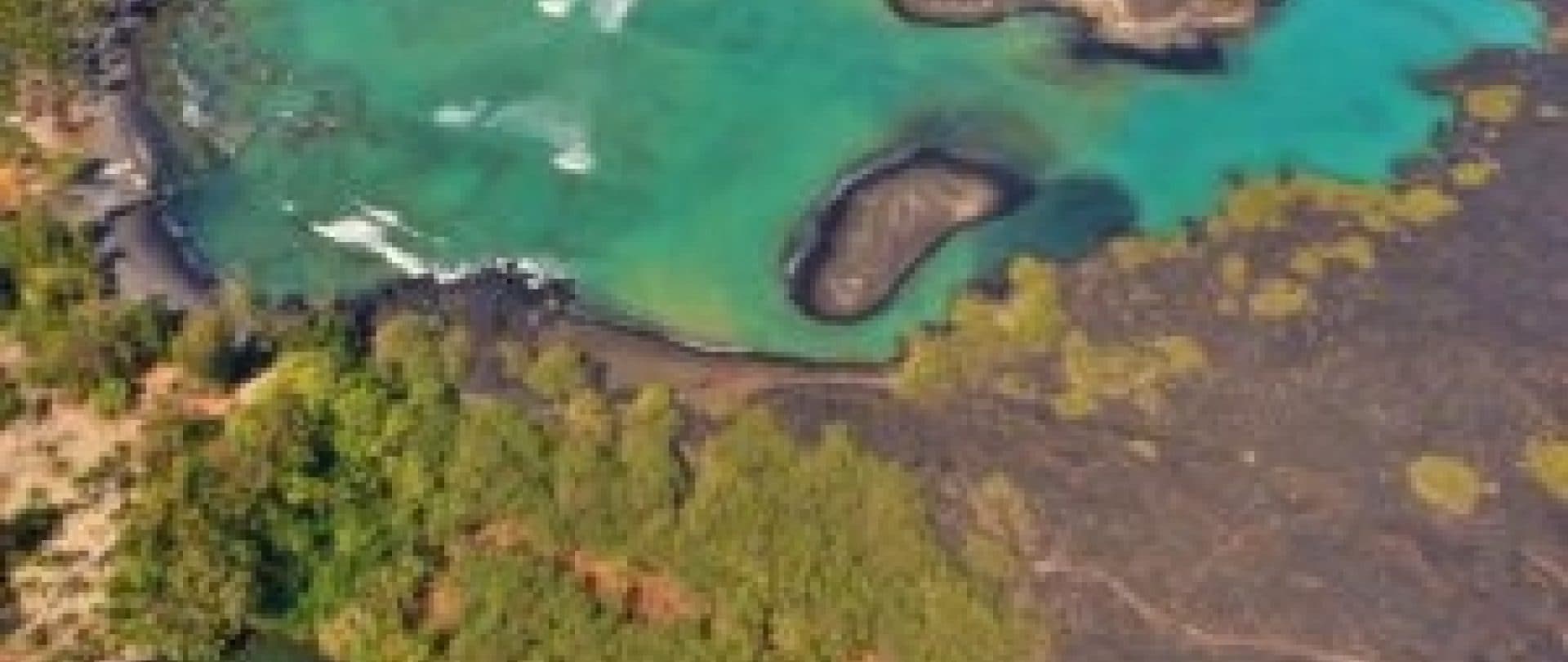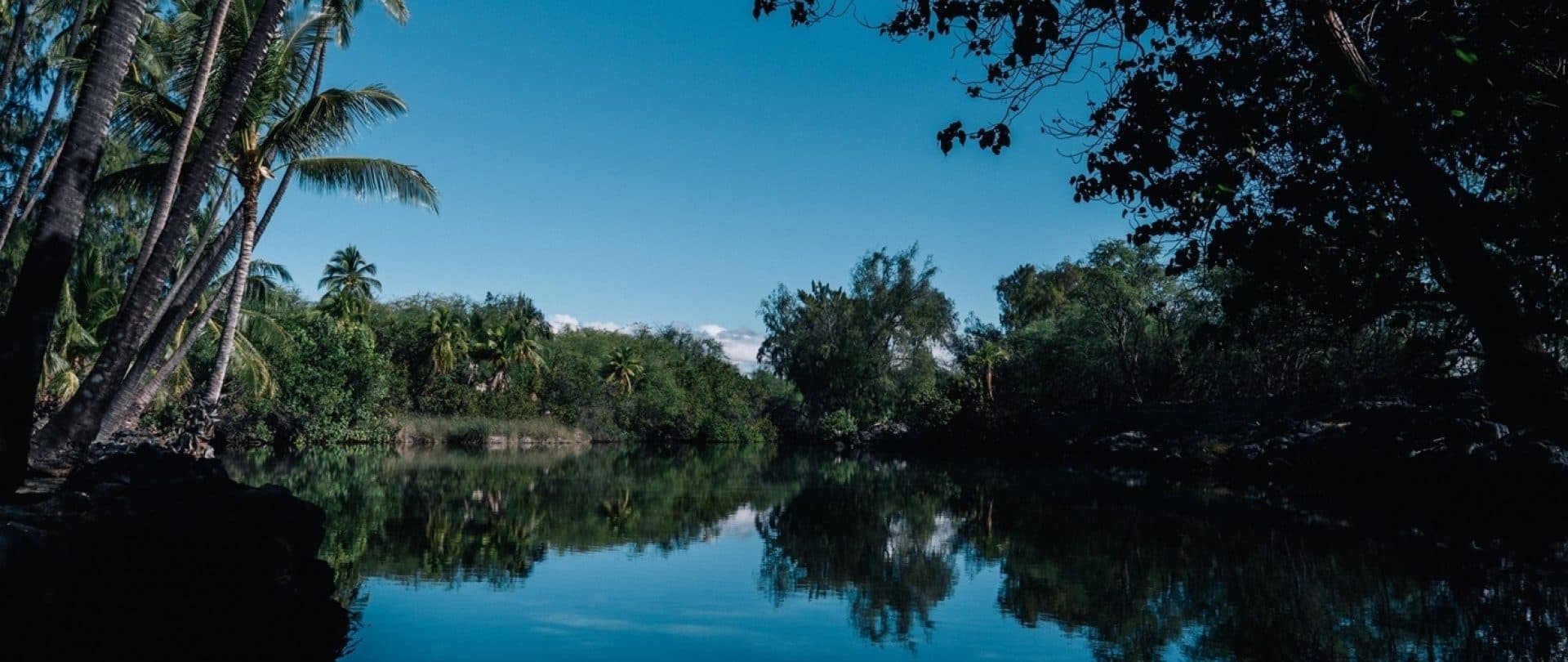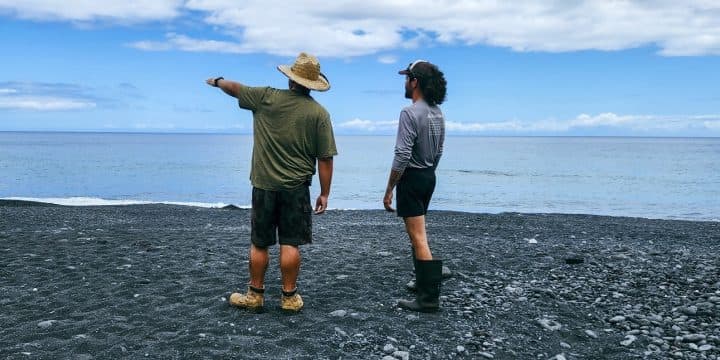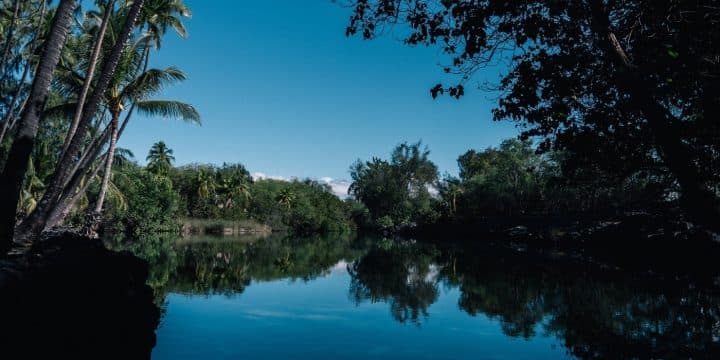The Voice of Kīholo Bay
Preserving a cultural and ecological treasure
BY Sara Stover
Envision a journey along North Kona’s arid coast, culminating in the serenity of a bay. As you approach the invigorating waters, the gentle rhythm of waves caressing the sleek, black stones of Kīholo fills your ears. This is a moment etched in the memories of fishermen whose ancestral roots in the bay span generations. Fishermen like Sonny Keakealani, who, as a teenager in the 1950s, would plunge into Kīholo’s pond to helu (count) all the fish. Today, Aloha Kīholo Hui’s Kaleo Ortiz continues this tradition. “It’s the most rewarding aspect of my role as Hoa ʻĀina (a friend of the land),” he shares.
While Kaleo has been a member of the Hoa ʻĀina team for a few years and the Hui has been in existence since 2007, the ʻiliʻili stones of Kīholo—the polished stones leading to the water’s edge—have a natural origin in the lava that flowed from Hualālai to the sea in 1801. As the molten lava met the ocean and cooled, it fractured into pieces. These fragments, buffeted by the ocean for over a century, have metamorphosed into a beach of polished ʻiliʻili that produces a unique rhythmic sound when the waves crash against them.
This is the voice of Kīholo. A voice that was on the brink of being silenced by another lava flow from the Mauna Loa eruption of 1859, which reduced its fishpond to a mere 3.2 acres. While the current perils to Kīholo’s song may not be as overt, they are just as insidious and detrimental.
Located in the ahupua‘a (traditional land division) of Pu'u Wa'awa'a, Kīholo Bay forms the makai (coastal) area. Tied culturally, ecologically and historically to the mauka (upland) areas of Pu'u Wa'awa'a, the makai area was highly valued for its wai ʻōpae (anchialine pools) and water systems. In the early 1800s, King Kamehameha I commissioned Ka Loko o Kīholo, the Kīholo fishpond, which initially spanned nearly 600 acres. Enclosed by six-foot-high rock walls, Ka Loko o Kīholo served as a secure haven for juvenile reef fish to grow before being harvested by the community or swimming out to sea through the sluice gates. This is why our conservation efforts are crucial to preserving this unique ecosystem.
After the 1859 eruption, Kīholo became the coastal destination for the cattle drives of many North Kona and Waimea ranching families. Rock wall holding pens were built next to the two Waiaʻelepī pools and used as a watering place for the cattle. The rock walls and the pools have stood the test of time, an enduring reminder of Kīholo’s historical importance.
The submarine springs of Kīholo Bay bring millions of gallons of fresh water and nutrients through its fishpond to the sea each day. When Kīholo is healthy, this improves the productivity of nearshore coral reefs and reef fisheries. But Kīholo’s natural resources and the ecosystems they provide have suffered from decades of overfishing and an overflow of visitors to the bay.
By the late 1990s, between 200 and 400 people could be found parking, camping and living in the area. An array of associated hazards threatened the health of the resident monk seals, the green sea turtles that live in Kīholo’s ponds and travel through an ‘auwai
(stone channel) to coastal waters and the ‘ōpae ‘ula (tiny endemic shrimp) found solely in the
wai ʻōpae dotting Kīholo’s lava fields.
Many foreign species were released into and around the fishpond, including bullfrogs, snapping turtles, guppies, tilapia and mosquito fish, which are predators of the ‘ōpae ‘ula. The combination of organic matter and overgrown vegetation eventually blocked freshwater springs, increasing the water’s temperature and saline levels. In one pond, the detrimental conditions led to the disappearance of the ‘ōpae ‘ula altogether.
Keakealani, his daughter, Ku‘ulei Keakealani, and other families with generational ties to Kīholo heard its kāhea (call) over all the racket. They responded by forming Hui Aloha Kīholo in 2007 to launch restoration efforts and perpetuate Kīholo’s ecological and historical significance. Under a Curatorship Agreement, 4,362 acres, including eight miles of wildland coastline, were designated the Kīholo State Park Reserve and became jointly managed by the State Parks Division and the Hui.
“Sanctioned by the families, the Hui started by closing Kīholo for two-and-a-half months to clean her up, restoring the roads and establishing campsites,” says Hui Aloha Kīholo’s Executive Director Chad Wiggins. The Hui removed sediment from decomposing organic matter in Ka Loko o Kīholo, restoring the fishpond to its former depth, reducing erosion and flooding and opening the springs.
In the 1970s, hair care product icon Paul Mitchell moved to Hawai‘i and started an awapuhi farm before passing in 1989. Mitchell’s son, the late Angus Mitchell, honored his father’s memory by donating approximately seven acres at Kīholo Bay, including the historic fishpond, to The Nature Conservancy (TNC) for a preserve in 2011. As concerns mounted over the aquaculture system crossing a threshold it could never return from, the philanthropic gesture couldn’t have come at a more pivotal time.
With help from expert dry-stack masons and nearly 6,000 volunteers who logged 27,000 hours over the past several years, TNC rebuilt Ka Loko o Kīholo’s toppled walls. The TNC team then began growing seedlings in the preserve’s on-site nursery and planting native pohuehue vines and ‘ae‘ae ground cover.
Thanks to the help of volunteers and the expertise of cultural practitioners, caretakers, scientists and state resource managers, TNC and the Hui are establishing Kīholo as a hub for conservation, education, partnership and sustainable harvest. At educational events, kūpuna share ancestral wisdom through stories and demonstrate traditional practices for community groups and students.
Twice a quarter, Kīholo volunteers help to clear kiawe trees and other invasive plants that choke waterways so native plants can be revived. Every year, volunteer groups remove overhanging vegetation from the fishpond’s perimeter. They also make a concerted effort to capture and remove invasive fish so the pond’s native fish populations can thrive once more. Keakealani has even demonstrated how to throw a net and catch thousands of invasive fish, transferring place-based knowledge to the volunteers.
Hoa ʻĀina, like Ortiz, carries on tradition and helu every fish in the Ka Loko o Kīholo monthly. And according to collected data, Kīholo’s habitat now hosts two dozen native fish species. Once prevalent fish like moi and striped mullet are making a comeback, as are endemic hapawai (mollusk) and ‘ōpae ‘ula. A pair of endangered aeʻo (Hawaiian stilt birds) never observed at the fishpond were spotted at Kīholo for the first time in 2020 and have since been seen mating. The kioea threatened migratory seabirds, have also returned to the area, as have the ʻōpeʻapeʻa (Hawaiian hoary bats).
“We see visitors picking up trash at Kīholo, which is a sign of success from a community activation perspective,” Wiggins says.
“We can see the fishpond’s shoreline now. And the ancient rock walls around it,” Ortiz adds, affirming that efforts to restore Kīholo Bay’s coastal health and marine life are clearly working. What isn’t always clear, however, is what is and is not off limits when visiting Kīholo.
“One of the problems we’re still facing is visits to Kīholo Preserve. It’s against the law to go in the preserve, but there’s a lot of misinformation out there,” says Evelyn Wight, TNC Hawai’i’s Senior Communications Manager. “The coastline is open to the public, as are all coastlines in Hawai’i, and public use is permitted at Kīholo State Park Reserve and the campground. But Kīholo Preserve is private property.”
Kīholo Preserve’s Keanalele Waterhole, often (and incorrectly) referred to as the Queens Bath, is a lava rock cave fed by fresh water passing from mauka to makai. Historically, families with generational ties to the area relied on Keanalele as a source of drinking water. To maintain the water’s purity, no one bathed or swam in Keanalele, and water was carefully drawn out with a container as needed.
Today, Keanalele is vulnerable to those who ignore private property signs, contaminating its sacred waters with bug spray, sunscreen, deodorant and other chemicals. The contaminated waters flow out to the ocean, polluting the nearshore estuaries that are home to baby fish.
When enjoying Kīholo Bay, contribute to its story of healing by being respectful and staying out of Kīholo Preserve, Keanalele, Ka Loko o Kīholo and other fishponds. Although visiting the preserve is not permitted, there are ample ways to experience the purity and power of Kīholo Bay, including camping at the State Park Reserve.
“Kīholo is now a much cleaner place for families. We can feed our spirits and our bodies and be revitalized here,” says Wiggins. “Respecting Kīholo’s cultural and natural landscape is as simple as being mindful of our individual footprint.”
As one of the last undeveloped bays on the North Kona Coast, visiting Kīholo is a priceless opportunity to hear the place's heartbeat and discover your place in its living, breathing landscape.
HERE’S HOW YOU CAN PROTECT AND RESPECT KĪHOLO
•Lava and water caves, including Keanalele, are archaeologically, culturally, and ecologically sensitive.
•For the protection of the caves, Hawai‘i State laws prohibit entrance to them.
•Kīholo has many cultural sites, and State law prohibits damaging or removing artifacts from these sites.
•Monk seals and sea turtles are endangered species, and it is illegal to approach them. In general, if you see any wildlife on land, sand, or sea, respect their space by keeping your distance.
•Kīholo’s history as a fishing village lives on, and local fishermen frequent the bay to fish for food for their families. Be aware that movement and noise can disrupt fishing, and respect local fishermen by keeping your distance.
•Walking north along the coast, you may be surprised to pass the occasional home. Please respect these private properties.
Learn more about Aloha Kīholo Hui, the hoa ‘āina (caretakers) of Kīholo, and opportunities to support restoration efforts by visiting huialohakiholo.org. Learn more about The Nature Conservancy and protecting Hawai’i’s land and water at nature.org.






